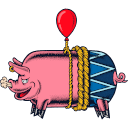
Plane Crazy
Plane Crazy is a 1928 American animated short film directed by Walt Disney and Ub Iwerks. The cartoon, released by the Walt Disney Studios, was the first appearance of Mickey Mouse and his girlfriend Minnie Mouse, and was originally a silent film. It was given a test screening to a theater audience on May 15, 1928, and an executive from Metro-Goldwyn-Mayer saw the film, but failed to pick up a distributor. Later that year, Disney released Mickey's first sound cartoon, Steamboat Willie, which was an enormous success; Plane Crazy was officially released as a sound cartoon on March 17, 1929. It was the fourth Mickey film to be given a wide release after Steamboat Willie, The Gallopin' Gaucho and The Barn Dance (1929).
Plot
Mickey is trying to fly an airplane to imitate Charles Lindbergh. After building his own airplane, he does a flight simulation to ensure that the plane is safe for flight, but the flight fails, destroying the plane. Using a roadster, a turkey's tail and the remains of his plane to create a new plane, he asks his girlfriend Minnie to join him for its first flight after she presents him with a horseshoe for good luck. They take an out-of-control flight with exaggerated, impossible situations. Clarabelle Cow briefly "rides" the aircraft.
Cast
More details
| author | Walt Disney |
|---|---|
| director | Walt Disney |
| events | aviation |
| genre | comedy |
| keywords | bloomer build charles lindbergh clarabelle cow exaggerated good luck charm parachute slap |
| musicBy | Carl W. Stalling |
| producer | Walt Disney |
| productionCompany | Walt Disney Animation Studios |
| publisher | Pat Powers |
| theme | animated animated short cartoon short silent |

